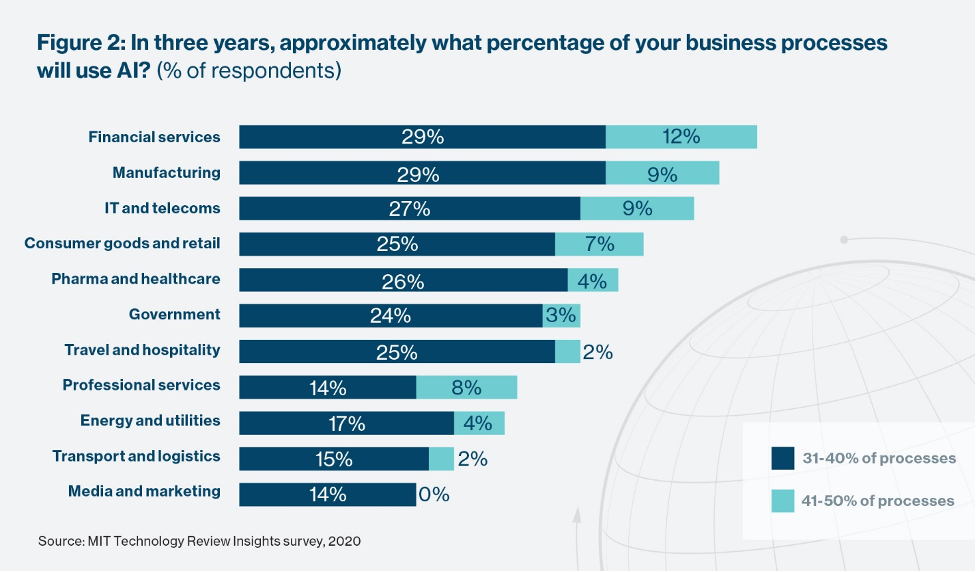
AI is everywhere, but it’s not yet ubiquitous. Last year, researchers from MIT surveyed 1000 enterprises across 11 industries and found that 97% had adopted or planned to adopt AI. With that said, 60% of executives said that AI would be between 11% and 30% of their processes within three years. In other words, nearly every company in every industry is adopting AI in some way, but most employees within those companies won’t get their hands on AI products any time soon.
This may not be encouraging information for most AI boosters, but it’s very useful. Research like this allows us to see where AI encounters bottlenecks within the adoption process. We can also see which industries adopt AI as part of core business processes and have shunted AI to the periphery. Lastly, we can look at AI success stories—where AI is core to a company’s business model and is used widely throughout the organization—and understand how to replicate their success.
AI Adoption by Industry
Let’s start by taking a look at how each surveyed industry intends to deploy artificial intelligence technology. Remember, each industry below has already adopted (or plans to adopt) AI—this visualization shows how many processes will involve AI by around 2023.

Breaking this down, we can see that:
- About one-third of financial services, manufacturing, and IT and telecoms companies will adopt AI within up to 40% of their processes by 2023.
- About one-fourth of retail, healthcare, travel, and government organizations will hit the 40% adoption mark within three years.
- Around 15% of professional services, energy, logistics, and marketing companies will place AI within up to 40% of their processes within the next three years.
At first glance, these adoption figures are what you might expect. Of course financial services are adopting AI at a rapid clip—this is corroborated by other studies saying that 54% of financial services organizations have already adopted AI. Strong AI adoption also makes sense for IT companies, because they’re either developing AI themselves or they’re channel partners for other AI vendors. Lastly, manufacturing is in desperate need of AI in order to augment its diminishing workforce.
As you move down the list, however, you begin to see some surprises. Government, for example, is rarely touted as being at the forefront of technology, but 25% of government organizations surveyed will implement AI in up to 40% of their processes by 2023. Meanwhile, there have been tons of articles hyping the integration of marketing with artificial intelligence, but only 15% of marketers will reach the 40% threshold within three years, and none expect to reach 50% integration.
What’s happening here?
This apparent disparity has to do with whether these industries can use AI at their core or at their periphery. With an industry like finance, companies can use AI as part of their core product and their ancillary workflows. They can use AI to create new banking products, personalize offers, and perform stock trades (all of which are central to the finance business model), but they can also use it for ancillary workflows such as fraud detection and cybersecurity.
Meanwhile, there are some industries where AI adoption is going to be much narrower. In marketing, for example, you can use AI for a lot of your central product offering, but you can’t replace your core marketing stack with artificial intelligence. In addition, it’s harder to find ancillary workflows that AI can support—there’s no need for fraud detection in the marketing context.
Barriers to AI Adoption within Companies
Businesses tend to be conservative about operationalizing AI technology. Many AI projects die in the pilot stage. In addition, many AI projects that succeed in the pilot stage are ancillary to the company’s core model. This often sets the tone for future projects, which is how you end up with companies that deploy AI aggressively in non-core workflows without really using it in their primary service offerings.
Companies that deploy AI well can identify areas which are close to their core business model, which produce good results even with small successes, and which are able to scale. The MIT report cites Walmart as an example—the company achieved success by applying AI towards optimizing inventory management costs. Walmart has an endless need for inventory management, and small improvements can propagate across the entire company.
Not every company can capitalize on AI in the same way. Some companies cite regulations as a barrier to AI adoption. Others find that a shortage of talent prevents widespread use. Other companies cited difficulty preparing and integrating data.
At Bitvore, we specialize in helping our customers operationalize artificial intelligence. Working with our customers, we can help them combine their existing data sets with our own intelligence to create models that can help them make accurate predictions. For more information, contact Bitvore today.

